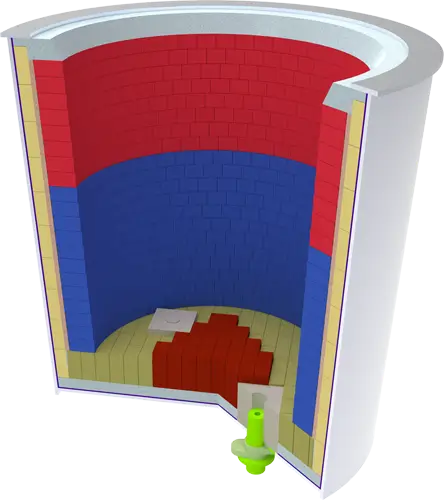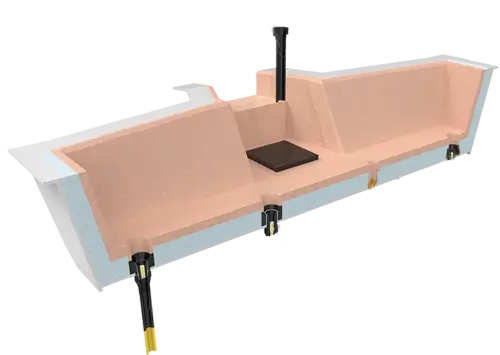Steelmaking refractories include the lining of liquid iron, liquid molten steel containers and related furnace protection and heat preservation materials, which can be specifically divided into ladle lining, converter lining, ladle lining and intermediate ladle lining and related supporting steel outlet, sliding water outlet, continuous casting of the three major pieces of fixed refractory materials, and furnace filler, refractory slime, dry materials, casting materials, diversion sand, covering agent, protective slag and other non-conformable bulk materials, such as more than 130 kinds of materials.
Hot Metal Ladle
The ladle bears the task of receiving molten iron from the blast furnace outlet and blending the molten iron into the converter for smelting.The usual temperature range of the molten iron is about 1200~1370℃, and its service process has to withstand the impact of extreme cold and heat, therefore, it is required that the iron package resistant material has to withstand frequent hot and cold changes, and the package lining has to maintain the rigidity shall not be due to the cooling of the heat process of the resistant material to disintegrate or produce gaps.
1.Brick-lined iron package
Brick lining iron ladle used in the working layer of the main refractory material for the low aluminum silicon carbide carbon brick, permanent layer for the three layers of clay bricks, low aluminum silicon carbide carbon brick has a resistance to scouring and do not stick to slag and other properties, compared with the magnesium carbon bricks of the steel ladle has a lower price and better performance, brick lining iron ladle is mainly used for railroad transportation of iron.
2.Integrated casting iron package
The ladle used for transferring iron water in the plant is cast with casting material as a whole, and the casting material is Al-SiC, which has a compact working cycle, and the degree of bearing severe cold and heat is lower than that of the ladle transported on the railroad line, so the life span is longer than that of the one on the railroad line.In recent years, by thickening the thickness of the impact zone at the bottom of the ladle to extend its life, and by applying anti-sticky slag agent to the mouth of the ladle to reduce the impact on the life of the ladle due to the treatment of sticky slag at the mouth of the ladle, the life of the ladle has been increasing year by year.
Ladle Furnace
The ladle has the dual task of carrying the steel and refining it outside the furnace. Steel temperature range of about 1550 ~ 1620 ℃ in the ladle, the ladle service process to withstand the impact of extreme cold and heat. Due to the extremely harsh conditions of the refining ladle, the arc of the slag line parts and the package wall parts of the erosion is very serious, resulting in the destruction of the refractory material ahead of the main reason for restricting its service life, so the brick lining of the ladle than the iron ladle brick lining requirements.
1.Tundish permanent lining
The castables for ladle are corundum-spinel castables with good resistance to slag erosion and penetration as well as excellent resistance to spalling, which can well resist the above mentioned erosion, and the current permanent lining of ladle has a service cycle of about 1.5 years.
2.Steel ladle work lining
The ladle working lining is mainly aluminum-magnesium (carbon) refractory material, in order to improve the life of the ladle, for the ladle slag line bricks, breathable bricks, slide plate and water spout bricks and other key parts of the refractory material, should be kept in sync with the life of the ladle lining.
3.Bottom blowing breathable bricks
The bottom of the ladle pre-embedded breathable bricks, through the argon gas stirring effect on the molten steel temperature and composition of the effective homogenization, and make the non-metallic inclusions smooth uplift, the use of slit-type breathable bricks, a steel ladle service life within the replacement of two breathable bricks.
4.Ladle upper nozzle and slide gate plate
Ladle water mouth is the ladle steel into the middle of the ladle channel, and the slide plate is to control the amount of steel into the middle of the ladle size, the material are magnesium-carbon, the life of less than the process requirements, need to be replaced.

Tundish Furnace
Intermediate package steel temperature of about 1470 ~ 1560 ℃, because the intermediate package in the casting to leave a certain thickness of residual steel, and down the line when the plug bar and residual steel frozen in the intermediate package, down the line of the intermediate package after cooling with the removal of the work lining, belonging to a one-time service after the work lining is scrapped, so the intermediate package of the work lining of the requirements of the ladle is not as high as that of the ladle.
1.Permanent lining casting material
The permanent lining of the intermediate ladle usually uses aluminum-silicon castables, which should have good strength, volume stability and thermal shock resistance according to the conditions of use of the intermediate ladle. The intermediate package adopts D57 castable material, and the life of one service cycle is about 700-800 furnaces.
2.Working lining dry material
Intermediate package magnesium dry lining has the advantages of easy construction, high baking thermal efficiency, steel slag and permanent lining easy to detach, intermediate package turnover, steel quality improvement, long service life and so on has been widely used, the main raw material for the electrofusion of magnesium sand, according to the different types of steel intermediate package age according to the control of the 10 ~ 40 furnace.

Continuous casting of three major components
Long spout, plug bar and immersion spout are the key functional refractory materials to realize continuous casting, and their performance directly affects the continuous casting efficiency and billet quality.
Large bag with long shroud
The main function of the shroud is to isolate the air during the pouring process of molten steel to prevent the secondary oxidation of the molten steel and the inhalation of nitrogen. The material of the shroud is aluminum carbon. The service life of ordinary steel is 9 to 10 furnaces, and that of special steel is 2 to 6 furnaces. control.
Monoblock Stopper
The integral stopper rod is a key component for controlling the flow of molten steel injected from the tundish into the crystallizer to ensure continuous casting production. The materials of the stopper rod are magnesium carbon and aluminum carbon, which are used on aluminum-containing steel and ordinary carbon steel respectively. The service life varies from 10 to 40 furnaces depending on the type of steel.
Upper Nozzle
In the stopper rod controlled casting system, the tundish water inlet is the distributor for the molten steel to flow into the crystallizer. The outer layer is aluminum carbon and the inner layer is inlaid with high melting point ZrO2. It is resistant to corrosion and has slow expansion. It is different from other material water inlets. In comparison, the continuous steel pouring time of a single tundish can be significantly improved.
Submerged Entry Nozzle
The main role of the immersion type water mouth is to prevent the secondary oxidation of steel, control the flow state of steel, promote inclusions floating as well as to prevent the crystallizer to protect the slag involved in the steel, whether slab or billet immersion type water mouth are used in aluminum carbon. Continuous casting “three big pieces” in addition to the plug rod and intermediate packet on the water mouth must be synchronized with the life of the intermediate packet, the big packet of long water mouth and immersed in the mouth can be changed through the slag line or replacement and new to maintain synchronization with the life of the intermediate packet.
Other Refractory Products
Shaped refractories also include impact bricks for iron ladles, impact bricks and seat bricks for the bottom of ladles, impact bricks, impact plates, retaining walls, retaining dams, seat bricks, profiled billets, clay billets for intermediate ladles, and so on.
